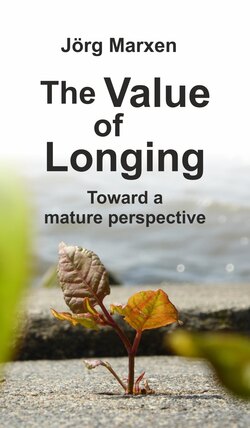Читать книгу The Value of Longing - Jörg Marxen - Страница 7
На сайте Литреса книга снята с продажи.
ОглавлениеThe field of longing
Longing has a function.
Longing springs from a source.
Longing has an effect.
Longing can have a very destructive effect.
Longing can, however, also have an exceptionally
constructive effect.
Longing and how we deal with it are in play as an effect but also as a cause, for example when relationships fall apart or when relationships, our attitude to life, our capacity for pleasure and our performance capability develop more favorably or less favorably. They are in play when a happy couple is expecting a child and then during the pregnancy or after the birth of the child the partner falls in love with another woman, or at least begins a sexual relationship with someone else. Longing can lead us into new situations against, through or even despite great reservations, in which we encounter new people and new challenges and in which we first have to reorient ourselves.
In the field of religiosity, spirituality and transcendence, too, it is usually very much about longing and how we deal it.
Longing constantly affects our lives in many areas.
The German dictionary of the Brothers Grimm (1971) devotes a long paragraph to the phenomenon of longing [German: Sehnsucht] and its facets with numerous statements, one of which is that we can understand longing as being …
… a high degree of intense and often painful desire for something, particularly if there is no hope of attaining what is desired, or when its attainment is uncertain, still far away.
Dictionary of the Brothers Grimm (Grimm, J. & Grimm, W., 1971)
This quote is also used by the Sehnsucht researchers surrounding Paul Baltes, Alexandra Freund and Susanne Scheibe (Scheibe et al., 2007), who start from a developmental perspective of the entire life span and whose definition and characterization I essentially follow.
They characterize the phenomenon of life longings with the aid of six criteria:
1. their unrealizability
2. a sense of incompleteness and imperfection in one’s own life
3. a tritime focus
4. the accompanying phenomenon of bittersweet or sweet-bitter feelings
5. the observation that life longings invite one to look back and evaluate life and life options
6. and their symbolic character and symbolic richness.
They define their understanding as follows:
The first two characteristics go hand in hand; on the one side, the thoughts, desires and emotions associated with personal utopias or the search for an optimal life and on the other hand, the accompanying sense of incompleteness and imperfection in life. Together, these two aspects generate the bitter sweetness or sweet bitterness of life longings, the combination of desire and disappointment and the search for ways to deal with this conflict.
Longing can help us to develop vision. In the feelings of well-being that arise when we imagine our dreams materializing, its quality of sweetness becomes apparent.
By contrast, it can be bitter when we realize that what we long for, what seems like the fulfilment of our dreams, is not fully attainable, is not attainable in the foreseeable future, or indeed at all, and turns out to be permanently unattainable.
A tritime focus does not mean that the entire life span from childhood to the present and into old age is necessarily always considered and borne in mind. However, it is assumed that the feeling of longing always extends from the present moment back into the past as well as forward into the future.
Given this background and often laden with ambivalent feelings, longing can cause us again and again to look back on the life we have lived and can follow us, prompting us to evaluate what is harmonious and fulfilling, what has been successful and what we still have to learn.
Another essential characteristic is the wealth of symbolic meaning. If we keep the symbolic richness in mind, we see that longings are much more than a specific type of behavior or experience. We see that the specific objects or goals of longings are connected to broader mental and emotional representations of what they stand for. We peer into a large, wide space behind them, or at least have an inkling of that space.
According to this characteristic of longing, a specific desire or yearning, for example for a hug from someone you love, is not necessarily a manifestation of longing. According to Baltes, a wish is only seen as a manifestation of longing when the mental and emotional representations associated with it are connected behind it with a larger construct of thoughts and feelings about the direction of one’s own life. Seen in this light, the desire for a hug could of course be only a mundane wish but behind this could also be the longing for intimacy in general.
So far for the findings provided by the researchers surrounding Paul Baltes (cf. Scheibe et al., 2007).
